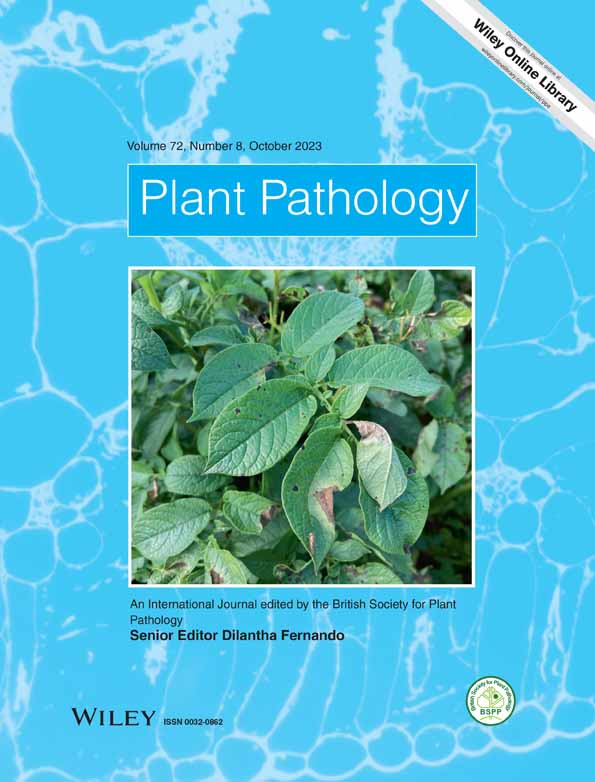Ver ítem
- xmlui.general.dspace_homeCentros e Institutos de InvestigaciónCIAP. Centro de Investigaciones AgropecuariasInstituto de Patología VegetalArtículos científicosxmlui.ArtifactBrowser.ItemViewer.trail
- Inicio
- Centros e Institutos de Investigación
- CIAP. Centro de Investigaciones Agropecuarias
- Instituto de Patología Vegetal
- Artículos científicos
- Ver ítem
Low water availability increases susceptibility to peanut smut (Thecaphora frezzii) in peanut crop
Resumen
Peanut smut (causal agent Thecaphora frezzii) and seasonal drought are the two main factors reducing peanut yields in Argentina. There are no previous studies about the effect of drought on peanut smut occurrence. We evaluated the effect of soil water limitation on smut symptoms in greenhouse and field assays. Additionally, we analysed the biochemical responses of plants to the combined stress caused by water limitation and smut infection in greenhouse
[ver mas...]
Peanut smut (causal agent Thecaphora frezzii) and seasonal drought are the two main factors reducing peanut yields in Argentina. There are no previous studies about the effect of drought on peanut smut occurrence. We evaluated the effect of soil water limitation on smut symptoms in greenhouse and field assays. Additionally, we analysed the biochemical responses of plants to the combined stress caused by water limitation and smut infection in greenhouse experiments. We found that a moderate water deficit (30% of soil water-holding capacity) increased smut symptoms and differentially increased proline and reduced chlorophylls in the host. Subsequently, we studied the correlation between field precipitation data and smut damage from 2015 to 2020 in naturally infected fields with a high T. frezzii spore load in the soils. Strong correlations between precipitation and severely affected pods, severity disease index and incidence were found from January to March (susceptibility window for T. frezzii infections). We suggest a strategy of irrigation in a specific time frame to mitigate smut damage when there is a water deficit in the growing season.
[Cerrar]

Autor
Paredes, Juan Andrés;
Guzzo, María Carla;
Monguillot, Joaquín Humberto;
Asinari, Florencia;
Posada, Gisella A.;
Oddino, Claudio M.;
Giordano, Damian F.;
Morichetti, Sergio A.;
Torres, Adriana M.;
Rago, Alejandro Mario;
Monteoliva, Mariela Ines;
Fuente
Plant Pathology: (First published: 23 October 2023)
Fecha
2023-10-23
Editorial
Wiley
ISSN
0032-0862
1365-3059 (online)
1365-3059 (online)
Documentos Relacionados
Formato
pdf
Tipo de documento
artículo
Proyectos
(ver más)
INTA/2019-PD-E4-I090-001, Análisis de patosistemas en cultivos agrícolas y especies forestales. Caracterización de sus componentes
INTA/2019-PD-E6-I116-001, Identificación y análisis funcional de genes o redes génicas de interés biotecnológico con fin agropecuario, forestal, agroalimentario y/o agroindustrial
INTA/2019-PE-E6-I516-001, Mejoramiento genético y desarrollo de ideotipos de cultivos industriales (CI) caña, maní, yerba, mandioca, stevia, quinua y te para sistemas productivos resilientes
Palabras Claves
Derechos de acceso
Restringido
 Excepto donde se diga explicitamente, este item se publica bajo la siguiente descripción: Creative Commons Attribution-NonCommercial-ShareAlike 2.5 Unported (CC BY-NC-SA 2.5)
Excepto donde se diga explicitamente, este item se publica bajo la siguiente descripción: Creative Commons Attribution-NonCommercial-ShareAlike 2.5 Unported (CC BY-NC-SA 2.5)


